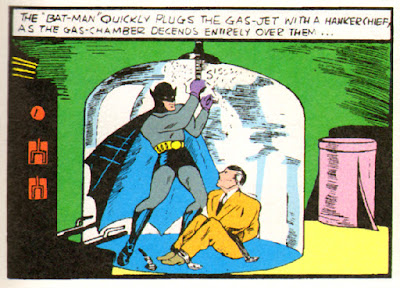I felt for her. Really, I did. Replace Joker with Batman and she could have been me when I was first interested in superhero comics. I had cut my teeth on manga that came in nice, organized trade paperbacks with numbers on the spine that told you where to start. At the time the most readily available superhero trades tended to come in phone book sized volumes with “Essential” in the title and a random selection of issues inside that didn’t follow complete story arcs. I couldn’t for the life of me figure out where I was supposed to start reading. Eventually I picked a trade that was an actual arc with an interesting sounding plot and used Google to fill in the rest.
Now though, superhero comics do increasingly come in trades with numbers on the spine, and to my great pleasure DC has started to release volumes of Golden Age stories. I can finally indulge my inner completionist that was galled by the thought of having to start in the middle of a series, and begin reading Batman from his first appearance in “Detective Comics #27.” With this series of reviews, I can take you, dear internet, along for the ride.
 |
| 64 Pages of Action! Six of which are actually about Batman... |
The story opens with Police Commissioner Gordon having a chat and a smoke with his socialite buddy Bruce Wayne. Gordon mentions being puzzled by the “Bat-Man,” then gets a phone call informing him that Lambert, the chemical king has been murdered, and invites Bruce to come along with him to the scene of the crime.
 |
| Apparently Old Lambert exists in that social sphere of people you know by name but are not at all shocked to find out that they have been murdered. |
The investigation proceeds with Bruce just sort of loitering silently of to the sides of the panels looking for all the world like he might be Gordon’s assistant if this were a different sort of detective story. Lambert apparently owned one fourth of a business with Crane, Rogers, and Stryker. A serendipitous phone call from Crane reveals that Lambert received a death threat and that Crane has also gotten one. At this point Bruce acts bored and excuses himself. Next thing we know Crane is murdered by a dude in a truly ugly orange and black striped suit who also steals a piece of paper from his safe.
 |
| Ok, he has almost no neck, but damn son, those are some shapely calves. |
At last our titular hero makes his first appearance. In the fight that follows there are a couple panels where the text above the panel directly narrates the content of the panel. This feels like a gross underutilization of a visual medium at best, and mildly insulting at worst. I know Batman is punching the guy, I can see him doing it. You don’t need to tell me. It’s also about here that I start losing my patience with quotation marks and a hyphen “Bat-Man.” The hyphen I’ll cede is simply a matter of being different from what I am used to, but consistently putting the character’s name in quotes feels a little exhausting after a while. One starts to imagine the narrator pausing to gesture with his fingers every time the “Bat-Man” is mentioned. Still, even burdened by awkward narration, our hero beats up the bad guys and steals back the paper. He reads it then zips off.
Rogers, one of the remaining business partners, goes to confront the final partner, Stryker. Stryker’s assistant greets Rogers, then promptly clubs him over the back of the head and sticks him under a gas chamber he uses to kill guinea pigs on account of him being a goddamn monster. Batman dashes in at the most dramatic moment to stop up the glass and break out of the dome from the inside for maximum action points.
 |
| Hold up. Just how big were those guinea pigs? |
In a completely unshocking turn of events Stryker turns out to be the evil one out of Lambert, Crane, Rogers, and Stryker. Batman confronts him over his questionable business choice of hiring assassins rather than just buying out his partners. Apparently the assassins were cheaper. Stryker goes to pull a gun, and “Bat-Man” punches him right into a vat of acid. It's a little jarring for for someone who grew up with a Batman with a rather aggressive no murdering policy. It does however set the stage for a much later use of the acid dunk as a potential origin of the Joker.
 |
| Murder by acid was kinda off, but ninjaing out of a conversation is spot on |
 |
| I’m more shocked that he is changing in his bedroom and not a cave, really. |
For the modern reader this story is missing a lot of iconic Batman elements. There is no cave, no gadgets, and no interestingly themed villain. The car we see Batman drive is a standard looking 30’s era coupe. It's also red with white wall tires, and a far cry from the sleek black Batmobile that feels more familiar. Also missing is the dead parents backstory. Instead it is implied that Bruce is out there fighting crime as some sort of cure for affluenza. Being rich is apparently terribly dull. What we do see in six short pages however is the beginning of a character who is both detective and action hero. He’s smart enough to piece together who the murderer is by looking at a business contract kept in a safe, and athletic enough to jump through windows and win fist fights on rooftops.
Both the writing and the art feel rather utilitarian. Neither is particularly bad, but they are lacking in any sort of flourish or refinement that might make them stand out as particularly interesting. The use of color feels particularly garish. I know that some of this is doubtless the fault of early four color printing, but I’ve seen enough contemporary work to know that not everyone at the time was quite this ham handed with the use of overly bright colors. During the final confrontation panel backgrounds switch between orange, green and pink without a lot of obvious reasoning. The whole thing feels a bit like a journeyman work, and I’m curious to see how it will progress into something more iconic.
Miz Opifex is a union electrician by day and a champion of feminine geekery by night. She lives in the American Rust Belt with her cat and a staggering amount of books, movies, and albums on vinyl.












